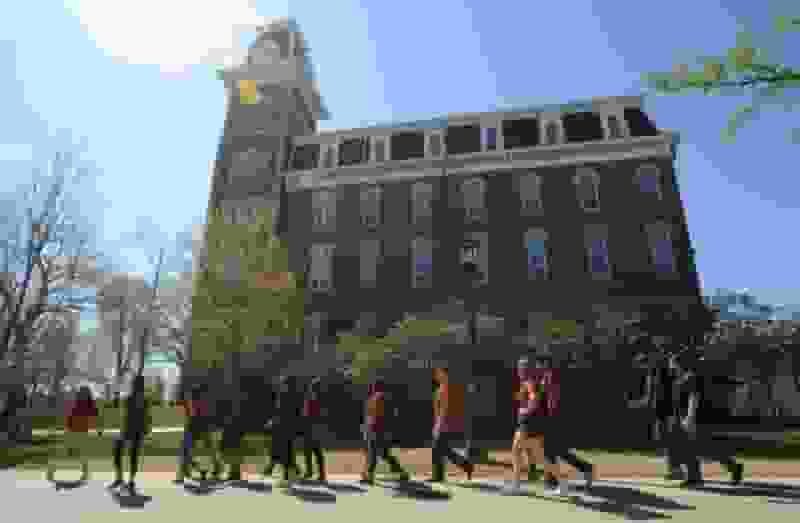According to early figures from the state Division of Higher Education, fewer students enrolled in the state’s public universities than a year before.
The recent drop is part of a long-term pattern, with only a few colleges experiencing a bounce-back year in terms of enrolment during the ongoing pandemic’s second autumn semester. The University of Arkansas at Fayetteville and the University of Arkansas at Pine Bluff had reductions not offset by gains at eight of ten state universities that primarily enroll undergraduate students, per Arkansas Democrat & Gazette.
For the sixth year in a row, total combined enrollment at the state’s 11 public colleges has decreased, falling from more than 100,000 students in fall 2016 to 92,188 students this year. The totals include increased enrolment at the University of Arkansas for Medical Sciences over the previous year. According to preliminary figures, non-high school enrolment at all public colleges fell by 1% to 85,985 from 86,836 the previous year.
Enrollment Figures 51 Schools in Arkansas Decrease
In Arkansas, 51 schools, including 22 two-year colleges, submitted fall enrollment figures. Except for North Park College in Hot Springs and Phillips Community College of the University of Arkansas in Helena-West Helena, all community colleges saw decreases in non-high school student enrollment.
According to figures omitting high school students taking college courses, undergraduate enrollment will decline for the 10th consecutive year, falling from 142,442 students in fall 2011 to a preliminary tally of 109,287 this autumn. According to Michael Miller, a professor of higher education at the University of Arkansas-Fayetteville, colleges in Arkansas and elsewhere have been studying population patterns for years, suggesting expected drops in students of traditionally college-going age.
Furthermore, Miller opined that individual universities are concerned about losing students because they need that financial stream from tuition and fee money to be where it is, or greater.
The University of Arkansas at Fayetteville acquired the most students this autumn, increasing its total enrollment to 29,068 from 27,562 a year ago. According to preliminary data, registration at UA-Pine Bluff, a historically Black university, increased to 2,748, up from 2,668.
Colleges must, however, determine their “appropriate size” and what programs to provide in light of declines elsewhere, according to Miller. On the one hand, many post-secondary institutions, particularly community colleges, have struggled with COVID-19, according to Miller. Part-time students may be unable to enroll due to pandemic disruptions to jobs or childcare, he said.

Community college enrollment fell to 39,697 from 40,238 a year ago, a 1.3 percent decrease.(Photo: Adobe Stock)
Population Reduction
According to preliminary data, community college enrollment fell to 39,697 from 40,238 a year ago, a 1.3 percent decrease. When concurrently enrolled high school students are excluded, the loss is much more pronounced, with preliminary statistics showing non-high school enrolment at the state’s two-year colleges falling to 28,923 from 30,488, a 5.1 percent drop.
Since 2010, Steve Cole has served as the chancellor of Cossatot Community College of the University of Arkansas. Thus, Cole said that all of the counties that they serve in southwest Arkansas; witnessed population reduction, according to the most recent U.S. census statistics. Also, he added that they saw several years ago diminishing high schools in the area. The college’s main campus is located in De Queen.
Impact of COVID-19 Pandemic on the Higher Education
According to state data, the college’s non-high school enrollment fell by 2.3 percent; to 875 students from 896 a year ago. Furthermore, to describe how enrollment losses affect the college, Cole remarked, they will buckle down and become leaner.
Nothing is status quo right now with COVID-19, according to Cole. He noted that the pandemic has impacted local jobs and disrupted some of the college’s training agreements with the industry. Cole stated that the college would continue to recruit in high schools as well as the general community.
According to preliminary data that excluded high school students attending college programs, private university enrolment grew to 14,749 from 14,598 a year before, a 1% gain. Harding University in Searcy, John Brown University in Siloam Springs, and Ouachita Baptist University in Arkadelphia all increased enrollment. However, eight of the state’s 15 private universities reported enrollment decreases. Lyon College enrollment fell by 12.1 percent to 581 students from 661 a year ago, and Philander Smith College enrollment fell by 11.1 percent to 710 students from 799.
Increase Financial Support for Incoming Students
Miller added that prominent participants in online education, such as Arizona State University, compete for in-state students, as do universities outside of Arkansas that want to attract vast numbers of out-of-state students.
Following a drop in enrollment last fall, the University of Arkansas at Little Rock announced an initiative to increase financial support for incoming students. According to preliminary state data, total enrolment has decreased by 6.8% to 8,297 from 8,899 students.
On Sept. 15, UALR announced that beginning in the fall of 2022, qualifying first-time first-year students and incoming transfers with 11 or fewer credit hours will have their course tuition and fees reduced by half for the first two years of their studies. Meanwhile, UALR offered a similar tuition-and-fees reduction to qualifying incoming first-year students this past summer.
Miller said that while cost is “an important element” in a student’s college decision-making process, he still expects “some rising costs” in higher education overall. In addition, he asserted that the universities that adapt to that kind of thinking and engage in more non-formal education would be the ones that thrive in the future.




![Tyson Foods Plant [Photo: Food Manufacturing]](https://southarkansassun.com/wp-content/uploads/2023/08/iStock_1185520857__1_.5e441daa51cca-600x337.jpg)







![Silverado Senior Living Management Inc. [Photo: Los Angeles Times]](https://southarkansassun.com/wp-content/uploads/2023/10/download-6-4-600x337.jpg)

![China's Wuhan Institute of Virology [Photo: Nature]](https://southarkansassun.com/wp-content/uploads/2023/09/d41586-021-01529-3_19239608-600x337.jpg)
















